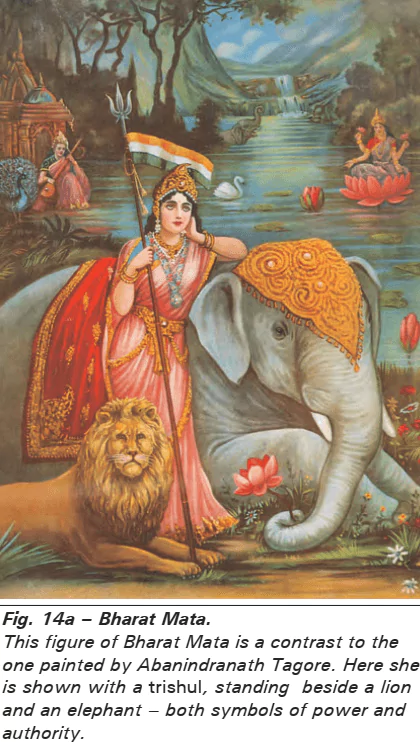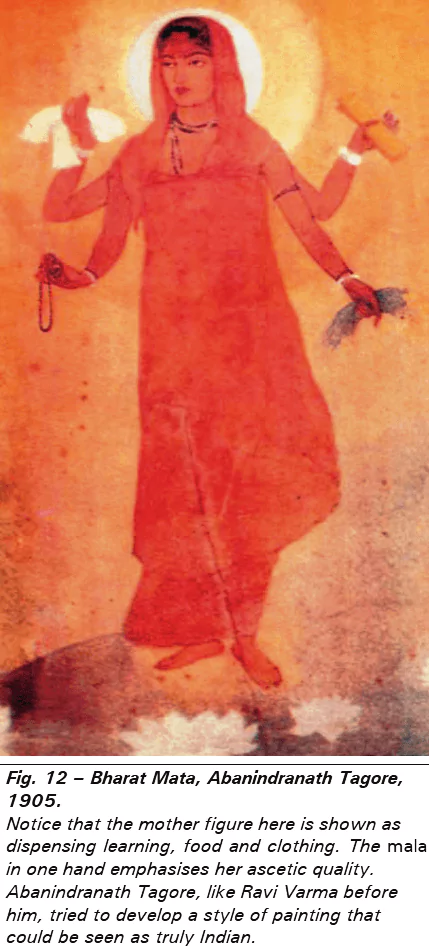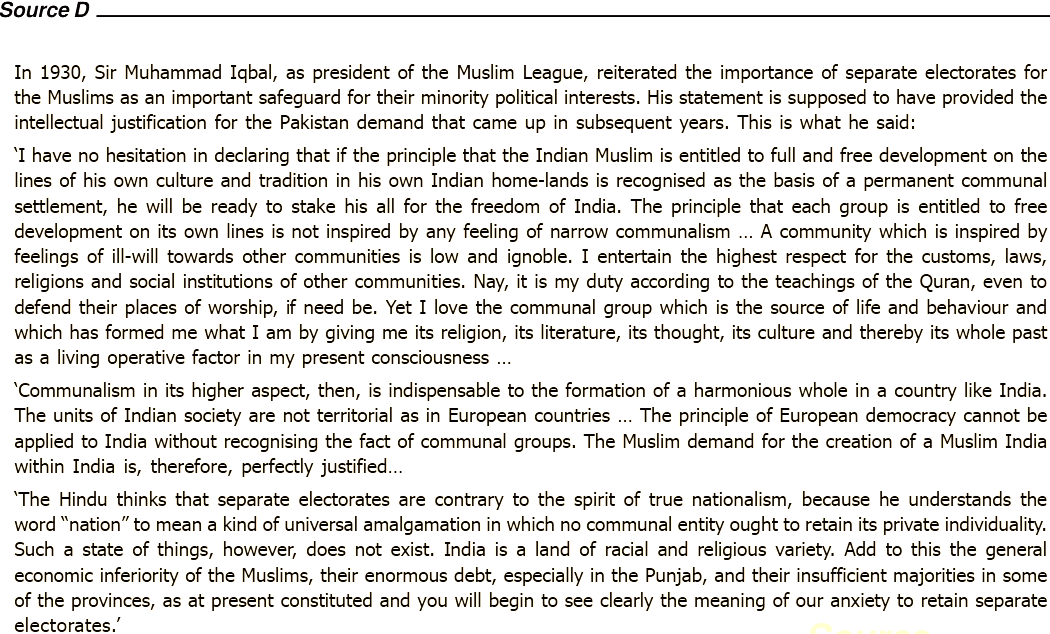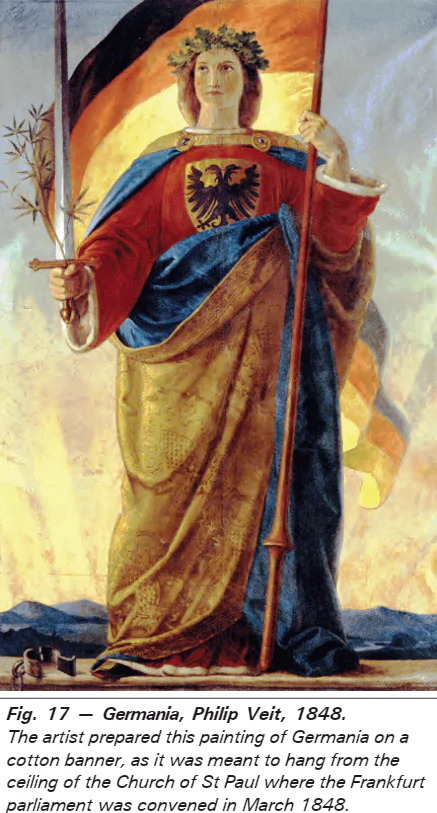NCERT Solution History Class 10 Chapter 2 Nationalism in India
In-Text Questions
Activity (Page 31)
Question.1. Read the text carefully. What did Mahatma Gandhi mean when he said Satyagraha is active resistance?
- Satyagraha does not mean to inflict pain on the adversary rather it is the source of soul.
- Truth is the substance of soul and so it is the substance of Satyagraha.
- It does not mean destruction but it means to clear the minds of adversaries and convert destructive thoughts into constructive by showing them love, compassion and truth.
Hence Satyagraha is active resistance.
Activity (Page 34)
Question.2. The year is 1921. You are a student in a government-controlled school. Design a poster urging school students to answer Gandhiji,s call to join the Non-Cooperation Movement.
Wake up call Throw the British rule in 1921!
Dear students,
Our Motherland India is suffering badly at the hands of Britishers, who are exploiting our countrymen socially and economically. Gandhiji has full faith upon the students of the country that they will fight for their motherland and make India an independent country. Join your hands with our beloved Bapu and immediately stop cooperating with the British government.
The success of the non cooperation movement depends on you.
Activity (Page 35)
Question.3. If you were a peasant in Uttar Pradesh in 1920, how would you have responded to Gandhiji’s call for Swaraj? Give reasons for your response.
I would have responded to Gandhiji call for swaraj in a positive non – violent manner. His way of truth and non- violence was the most potent way to attain swaraj, therefore, I would have followed him.
Activity (Page 36)
Question.4. Find out about other participants in the National Movement who were captured and put to death by the British. Can you think of a similar example from the national movement in Indo-China (Chapter 2)?
There were many participants in the National Movement who were captured and put to death or otherwise killed by the British. These included Bhagat Singh, Sukhdev, Rajguru, Chandrashekhar Azad, Lala Lajpat Rai, Khudiram Bose and Madan Lal Dhingra.
Discuss (Page 43)
Question.5. Why did various classes and groups of Indians participate in the Civil Disobedience Movement?
The various classes and groups of Indian participated in the Civil Disobedience Movement due to their own, limited motives. To them “swaraj” meant something they carved for.
For example:
- To businessmen, swaraj meant a time when colonial restrictions on business would no longer exist and trade and industry would flourish without constraints.
- Similarly to rich peasant classes, swaraj was a struggle against high land revenue.
- Women took swaraj as the attainment of elevated status and equality with men in Indian society.
- Poor peasants considered swaraj as the time when they would have their own land, would not have to pay rents or do beggar.
Working class dreamed for high wages and excellent working conditions.
Hence, swaraj was different for different classes and group of Indians.
Discuss (Page 45)
Question.6. Read the Source D carefully. Do you agree with Iqbal’s idea of communalism? Can you define communalism in a different way?
No, I do not agree with Iqbal’s idea of communalism as it was based upon the thought that India is a land of racial and religious variety.
That does not really mean that India needed any type of communal settlement or division on the basis of community.
According to me, communalism believes in the government of a specific community. It does not have any element of nation in it, which was the motive of nationalist struggle for India’s freedom.
Activity (Page 48)
Question.7. Look at Figs. 12 and 14. Do you think these images will appeal to all castes and communities? Explain your views briefly.
No, I do not think that these images would appeal to all castes and communities of India. Because, these images of “Bharat Mata” show her in the incarnation of a Hindu Goddess.
This gives a religious biasness to the image. It should be avoided. The image should reflect the nationalist idea of unity of all castes and communities.
NCERT Solution
Write in brief
(Page 50)
Question.1. Explain:
(a) Why the growth of nationalism in the colonies is linked to an anti-colonial movement.
In several colonies including India the growth of modern nationalism is intimately connected to the anti-colonial movement. People began discovering their unity in the process of their struggle with colonialism. The sense of being oppressed under colonialism provided a shared bond that tied many different groups together.
(b) How the First World War helped in the growth of the National Movement in India.
The First World War created a new economic and political situation. It led to a huge increase in defence expenditure which was financed by war loans and increasing taxes. Custom duties were raised and income tax was introduced.
Through the war years prices increased leading to extreme hardships for the common mass. Villages were called upon for supply of soldiers. Forced recruitment in rural areas caused widespread anger. Acute shortages of food due to failure of crops in several parts of India in 1918-19 and 1920-21 made the life of the common people miserable. People hoped that their hardships would end after the war was over. But that did not happen. All this helped in the growth of the national movement in the country.
(c) Why Indians were outraged by the Rowlatt Act.
- This had unbridled powers to the government to arrest and imprison suspect without trial for two years maximum.
- This had enabled the Government to suspend the right to ‘Habeas Corpus’ (a writ requiring a person to be brought before a judge or court), which had been the foundation of civil liberties in Britain.
- It caused a wave of anger among all sections and societies of India. It led to the first countrywide agitation by Mahatma Gandhi and marked the foundation of the Non-cooperation movement.
(d) Why did Gandhiji decide to withdraw the Non-Cooperation Movement?
- In February 1922, Mahatma Gandhi decided to withdraw the Non-Cooperation Movement. He felt the movement was turning violent at many places and satyagrahis needed to be properly trained before they would be ready for mass struggles.
- Within the Congress, some leaders were by now tired of mass struggles and wanted to participate in elections to the provincial councils that had been set up by the Government of India Act of 1919. They felt that it was important to oppose British policies within the councils, argue for reform and also demonstrate that these councils were not truly democratic.
Question.2. What is meant by the idea of Satyagraha?
When Mahatma Gandhi returned to India in January, 1915 he started a Satyagraha movement in India in various places.
- Satyagraha comprised of two Sanskrit words Satya and agraha. Satya means truth and agraha means path. Thus Satyagraha means following the path of truth and non-violence to attain freedom and fight against injustice.
- It is the philosophy of non-violent resistance adopted by Gandhiji to end the British Raj in India.
- The idea of Satyagraha emphasised the power of truth and need to search for truth.
- Satyagraha advocated that for true cause and struggle against injustice, physical force is not required to fight with the oppressor.
- Without being aggressive, a satyagrahi could win battle through non-violence.
Question.3. Write a newspaper report on:
(a) The Jallianwalla Bagh Massacre
(b) The Simon Commission.
Ans.(a) 14 April, Amritsar
Today I visited the Jallianwalla Bagh here. Yesterday this place had witnessed the ghastly scene which exposed cruelty of the colonial government in India. A crowd had gathered here to listen to their leaders who were to attend the meeting to show their protest against the repressive laws. Suddenly, General Dyer came with armed troops and closed the only exit and ordered the troops to fire on the crowd. Hundreds of innocent people were killed. This agitated Indian minds resulting in strikes, clashes with the police and attacks on government buildings.
Ans.(b) 4 February 1928, Bengal
A Statutory Commission under Sir John Simon set up in India in 1928 is in response to the nationalist movement and to look into the functioning of the constitutional system in India and suggest changes. But the commission has only British members, no Indian members. This was followed by a strike in Bengal on February 3rd, 1928. So when the Simon Commission arrived in India in 1928, it was greeted with the slogan ‘Go back, Simon’. To pacify Indians, the Viceroy Lord Irwin, announced in October 1929 ‘dominion status’ for India in an unspecified future, and a Round Table Conference was held to discuss a future constitution.
Question.4. Compare the images of Bharat Mata in this chapter with the image of Germania in chapter 1.

Abanindranath’s image of Bharat Mata shows her as imparting learning, food and clothing. A mala is worn by her, which shows aesthetic quality. Devotion to this mother figure came to be seen as evidence of one’s nationalism. One can say, it is similar to the image of Germania painted by Philip Veit, where she is holding a sword, but also looks more feminine. Whereas the other painting of Bharat Mata shows her more masculine in nature as it shows power and authority which is denoted by lion and elephant beside her in the painting. The latter image is more parallel to the image of Germania by Lorenz Clasen, where she holds a sword and a shield, and seems ready for a fight. In France she was Christened Marianne, a popular Christian name which underlined the idea of a people’s nation. Her characteristics were drawn from those of liberty and the Republic—the red cap, the tricolour, the cockade. Status of Marianne were erected in public squares to remind the public of the national symbol of unity. Similarly Germania became the allegory of the German nation. In a visual representations Germania wears a crown of Oak leaves, as the German Oak stands for heroism.
Discuss
(Page 50)
Question.1.List all the different social groups which joined the Non-Cooperation Movement of 1921. Then choose any three and write about their hopes and struggles to show why they joined the movement.
Different social groups which joined the Non-Cooperation Movement of 1921 are given below:
(i) Teachers and students
(ii) Merchants and traders
(iii) Lawyers
(iv) Countryside peasants
(v) Tribal peasants
(vi) Plantation workers in Assam
(vii) Nai and Dhobi.
(i) Teachers and students: Thousands of students left government-controlled schools and colleges. Headmasters and teachers resigned.
(iv) Countryside peasants: In Awadh, peasants were led by Baba Ramchandra, a sanyasi. The movement here was against talukdars and landlords who demanded high rents from peasants, and a number of other cesses. Peasants had to do begar and work at landlord’s farms without wages. These peasants demanded reduction of revenue, abolition of begar and social boycott of oppressive landlords. As the movement spread in 1921, the houses of talukdars and merchants were attacked, bazaars were looted and grain hoards were taken over. In several places, local leaders told peasants that Gandhiji had declared that no taxes were to be paid and land was to be redistributed among the poor.
(vi) Plantation workers in Assam: For plantation workers in Assam, freedom meant the right to move freely in and out of the confined space in which they were enclosed. It also meant retaining a link with the village from which they had come. Under the Inland Emigration Act of 1859, plantation workers were not permitted to leave the tea gardens without permission. When they heard of the Non-Cooperation Movement, thousands of workers defied the authorities, left the plantations and headed home. They believed that Gandhi Raj was coming and everyone would be given land in their own villages.
Question.2. Discuss the Salt March to make clear why it was an effective symbol of resistance against colonialism.
Mahatma Gandhi found in salt a powerful symbol that could unite the nation against the British government in India.
He sent a letter to Viceroy Irwin on 31 January, 1930 stating eleven demands from specific to general in the interest of all classes.
The idea was to make the demands wide-ranging, so that all classes within Indian society could identify with them and everyone would be brought together in a united campaign.
The most stirring of all was the demand to abolish salt tax. Salt was something consumed by the rich and the poor alike. It was one of the most essential items of food. Gandhi’s letter was an ultimatum.
It also threatened that if government did not exempt people from the salt tax then they would launch a campaign against it.
But Irwin showed reluctance and took the warning lightly. Thus, Civil Disobedience Movement was started by Gandhiji in the year 1930. It was an important milestone in the history of Indian nationalism.
The main ideology behind the Civil Disobedience Movement was to defy the laws made by the British.
Gandhiji started his famous salt march (Dandi March) accompanied by 78 followers, from his ashram in Sabarmati to the Gujarati coastal town of Dandi. On 6 April, he reached Dandi, and openly violated the law, manufacturing salt by boiling sea water.
Question.3. Imagine you are a woman participating in the civil Disobedience Movement. Explain what the experience meant to your life.
I participated in the National Movement for the first time by being a part of the Civil Disobedience Movement. It was feeling of pride for me. During Gandhi’s ‘Salt March’, I participated with thousands of women who came out of their homes to listen to him. We also participated in manufacturing salt, protest marches, picketed foreign goods and liquor shops. Women like me who came from the high caste families also joined in the protests in the urban areas. We all took part in the movements with great enthusiasm. We all stood by men and suffered physical blows with them. Even though it did not bring us any status in the movements but we all contributed in the struggle for freedom of our motherland. Even in Gandhi’s views, a women’s place was at home; as mothers, and good wives. The Congress also on the other hand did not give us any position in the organisation but we with all made our presence felt by our hard work and enthusiasm. There were many famous personalities amongst us like Sarojini Naidu, Kamla Nehru, Annie Beasant, who contributed to the national movements.
Question.4.Why did political leaders differ sharply over the question of separate electorates?
- The Indian political leaders differed sharply over the question of separate electorates because they believed that separate electorates would slow down the process of their integration into society.
- In 1930, Sir Muhammad Iqbal, President of the Muslim League, re-stated the importance of separate electorates for the Muslims as an important safeguard for their minority political interests.
- Dr. B.R. Ambedkar, who organised the dalits into the Depressed Classes Association in 1930, clashed with Gandhi at the second Round Table Conference by demanding separate electorates for dalits. When the British government conceded Ambedkar’s demand, Gandhiji began a fast unto death. Ambedkar ultimately accepted Gandhi’s position.






